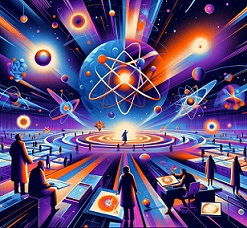Speaker
Description
Motivated from the observations of poorly understood explosive stellar phenomena associated with massive supergiant stars of zero-age main sequence (ZAMS) masses around 30–60 solar masses, new light has been shed on an old idea [1], namely, that the appearance of QCD degrees of freedom may account for such cosmic explosions [2]. Obeying nuclear physics constraints and taking yet another important observation of the very existence of massive pulsars of more than 2 solar masses seriously into account, puts sever constraints on the behaviour of the equation of state at supersaturation density. In particular, sufficient stiffness with increasing density is required, which puts the frequently employed class of bag models into jeopardy. During the supernova evolution of very massive progenitor stars, with ZAMS masses of about 30–75 solar masses, high core temperatures and densities are reached, where the appearance of the hadron-quark phase transition can potentially trigger not only the supernova explosion but also release a millisecond neutrino burst, which is absent in canonical neutrino-driven supernova explosions. This observable signature provides unique evidence for the presence of a first–order phase transition at supersaturation density. The future observation of such a feature, from the next galactic event, will allow us to either confirm such scenario or, if not observed, rule out a (strong) first-order phase transition at high densities encountered at the interior of (proto)neutron stars. In my talk I will revisit this scenario with special emphasis on observables, which concerns neutrinos [3] and gravitational waves [4], and their potential link to the yet incompletely understood high-density equation of state.
References
-
Sagert, I.; Fischer, T.; Hempel, M.; Pagliara, G.; Schaffner-Bielich, J.; Mezzacappa, A.; Thielemann, F.-K.; Liebendoerfer, M.; "Signals of the QCD phase transition in core-collapse supernovae”. Phys. Rev. Lett., 102, 081101 (2009).
-
Fischer, T.; Bastian, N.-U. F.; Wu, M.-R.; Typel, S.; Klähn, T.; Blaschke, D. B.; "Quark deconfinement as a supernova explosion engine for massive blue supergiant stars”. Nature Astronomy, 2, 980 (2019).
-
Khosravi Largani, N.; Fischer, T., Bastian, N.-U. F.; “Constraining the Onset Density for the QCD Phase Transition with the Neutrino Signal from Core-collapse Supernovae”. Atrophys. J., 964, 143 (2024).
-
Kuroda, T.; Fischer, T.; Takiwaki, T.; Kotake, K.; “Core-collapse supernova simulations and the formation of neutron stars, hybrid stars and black holes”. Astrophys. J., 924, 38 (2021).

